FTA (изд-во). Flexography: Principles And Practices. Vol.1-6
Подождите немного. Документ загружается.


206 FLEXOGRAPHY: PRINCIPLES & PRACTICES
the ink pan to rewet the dried ink in the
pan. Concentrate on areas where ink
buildup exists, rewetting the rag as
needed.
4. Wipe the ink pan dry using a second
rag when all ink buildup is removed.
Only a haze should remain.
5. Dampen another clean rag with clean-
ing solution to remove the remaining
pan haze. Immediately use a dry rag to
give it a final shine.
6. Use the two rags to clean the outside
of the pan and deck cover.
7. Remove the ink return hose. Wipe any
remaining ink out of the drain hole.
Label Ink Containers
The containers holding the ink used dur-
ing the run should be marked with the cor-
rect ink color and/or number. Any addi-
tives, bases or solvents that were added to
the ink, and their quantities, should be
noted on the containers.
Dirty cleaning solution must be removed
from the press and poured into a waste dis-
posal container where it will be recycled or
disposed of as hazardous waste.
Remove Unprinted Stock
Unprinted stock should be labeled and
returned to its assigned storage location.
Clean Tools and Press Area
All pH meters, viscosity cups and other
tools used during the pressrun should be
cleaned and prepared for use on the next
run. All spills and splashes around the
machine should be wiped up, not only for the
sake of appearance, but for safety as well.
Clean the Pumps
If submersible pumps are used, the opera-
tor should place the pump in a bucket of
cleanup solution and flush out the pump and
hoses. After flushing with cleanup solution,
the pumps should be flushed with fresh sol-
vent or water. Repeat these steps for each
printing station.
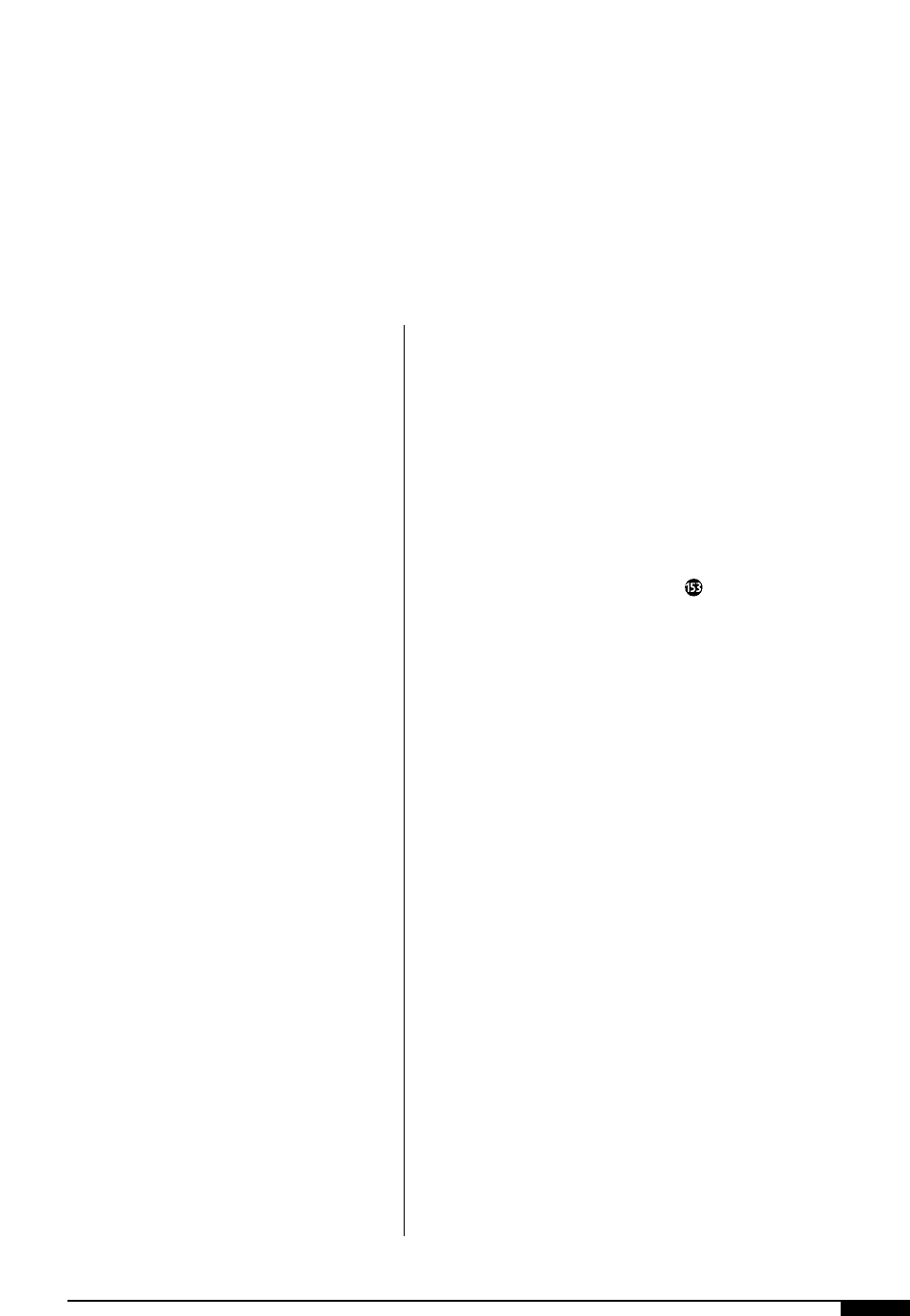
PRESSROOM PRACTICES 207
Corrugated
Press Procedures
T
he procedures for a corrugated
flexographic press setup, run
and cleanup vary depending on
the press manufacturer, the age
of the press and the different
methods used by printers. For
this reason, this section focuses on the
basics of setup that are common to most
corrugated printers.
PRESS SETUP
Corrugated press crews typically make
several setups each day. Each setup must be
made in the most time-efficient manner pos-
sible. In order to achieve a high level of effi-
ciency, it is important for the crew to look
ahead to future orders. Looking ahead allows
crews to coordinate the colors being run
from print station to print station and the
type of board being run. This coordination
creates better efficiency because the press
should not need to be broken down as much,
and only the stations to be changed need to
be washed for the next order. Crews must
plan ahead to have the next order’s ink, stock
and other materials ready before the existing
run is finished. Running a corrugated press
requires good communication and thorough
planning between the crew members.
Supply Assurance Precheck
A supply assurance precheck should be
completed prior to press setup. The follow-
ing items detail a typical precheck. All items
should be available and reviewed by the
crew before press setup:
Shop orders. Sometimes referred to as job
instructions, work orders or job jackets, this
order contains all of the instructions needed
to produce the finished product to the cus-
tomer’s specifications.
Print card. Sometimes called a print copy, this
card is a part of the shop order. It contains
specific instructions for the job being print-
ed, and provides information on dimensions,
position, color and quantity (Figure ). In
most cases, the card also contains a graphic
layout of the job.
Printing plates. Plates should be at the press
site and checked against the copy to be
printed.
Ink. Ink should be at the press site and
checked for the proper color and quantity.
Stock. Stock should be at the press site and
checked against the work order for size,
flute and test. Board test refers to the prop-
er liner, medium weights of stock and flute.
Once the crew has determined that these
items are at press side and meet require-
ments, the press setup may begin. All safety
lockout devices must be in the proper posi-
tion before beginning the setup.
Set the Feed Mechanism
The press setup is initiated by the setup of
the feed mechanism. The basic height of the
feed table is fixed in relationship to the bot-
tom feed roll, the pull roll collars and the
print cylinder with the plates attached.
First, the side-hopper feed guides and
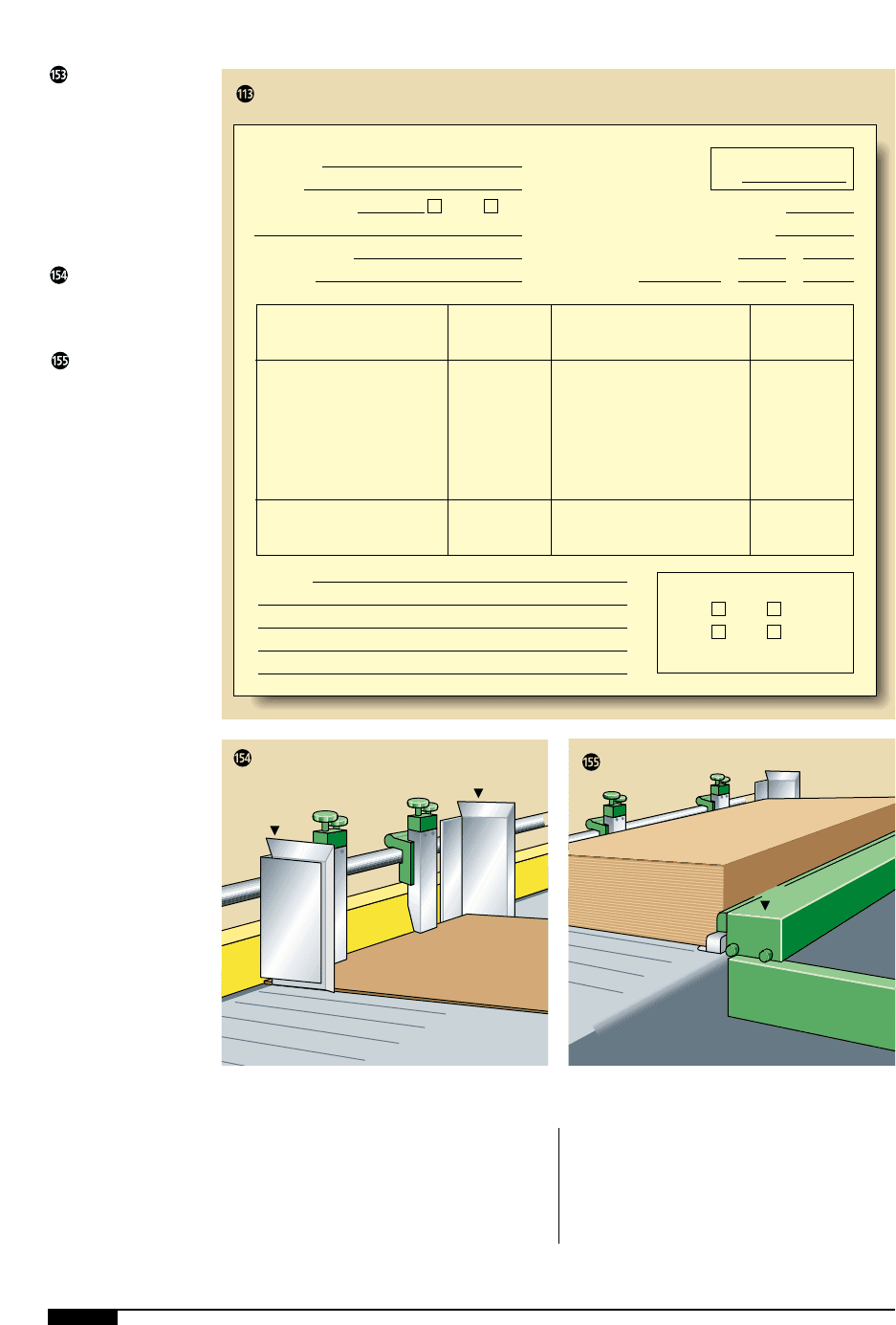
208 FLEXOGRAPHY: PRINCIPLES & PRACTICES
A print card layout
contains specific
instructions for the
job being printed,
including dimensions,
position, color, quantity
and in most cases,
a graphic layout of
the job.
Side guides are
mounted on a bar
across the feed table.
A back stop is set by
placing a stack of stock
within the feed guides
and adjusting to the
width of the blank.
backstops must be set. Many corrugated
presses set up over center, meaning that the
length of the sheet to be printed is in the cen-
ter of the press. The feed (side) guides are
mounted on a bar across the feed table and
have measurement tapes or scales attached.
They are adjustable on this bar from the cen-
ter of the machine to either side and are
locked by means of a screw-handle device.
Feed guides should be positioned on the
CUSTOMER
REMARKS
JOB#
BOX NO.
PLATES RECEIVED CUST
PLATES USED ON
REPLACES
PRINT
NO.
LOCATION
COLORS
PANELS
TRANSPARENCY
PRINT CARD
1
3
2
4
GPB
PE PRP
RE
MASTERS FOR DIES LOCATED AT
Side Guide
Side Guide
Backstop
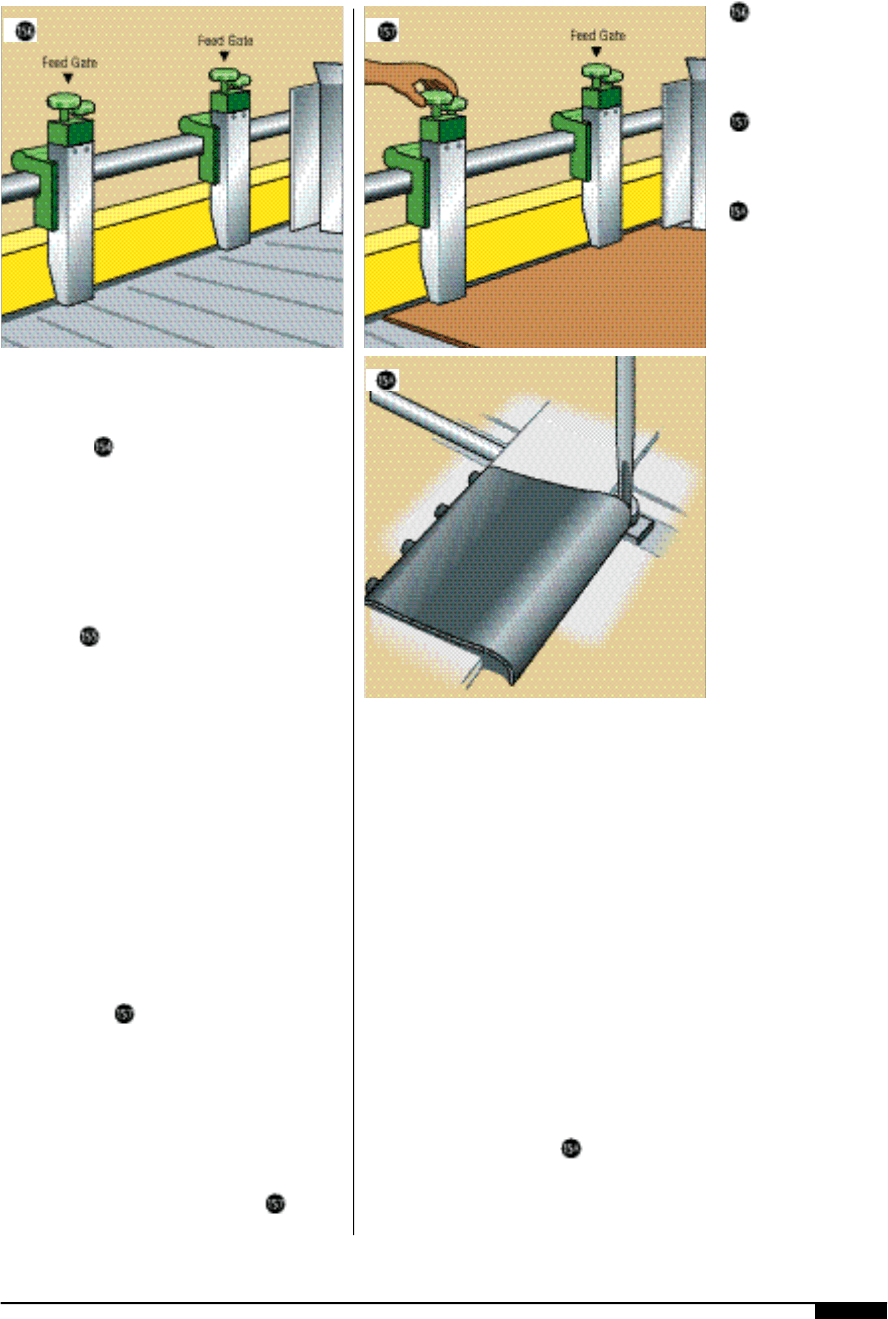
guide bar one-half the stock length from cen-
ter (Figure ) .
The backstops must be properly posi-
tioned in conjunction with the feed hopper.
Proper setting of the backstops is best
attained by placing a stack of the stock to be
run within the feed guides and adjusting
according to the width of the blank, as seen
in Figure ). This setting will vary depend-
ing on the type of feed style being used, such
as a kicker feed or a lead-edge feed.
Set the Feed Gates
Feed gates should be set to allow only one
flute thickness of stock to pass under it during
the feeding operation of the press. If the feed-
er should allow more than one sheet to pass at
a time, the press may jam. It is important to set
the feed gates for each job to be run. Similar
grades of corrugated board may differ in
caliper due to variations in manufacturing.
All corrugated presses have two feed
gates (Figure ). Once each gate has been
set for proper caliper, they each should be
placed at an equal distance between the feed
guides (hopper) and the center of the press.
The feed gates are adjusted by sliding one
sheet of board under the gate and allowing an
additional space the thickness of one-quarter
of the caliper of the board (Figure ) .
When working with a press that has a com-
puter control system, the setting should be
checked with a sheet of board and fine tuned
before the run.
Set the Feed Device
The two most common feed devices used
on direct-print presses are the kick feeder
and the lead-edge feeder. The kick-style
feeder hits the sheet from the rear edge to
push the board into the press. The lead-edge
feeder carries the sheet into the press from
the front edge of the sheet.
To adjust a kick feeder, the operator
should set the kicker bar to the width of the
board being run (Figure )
To adjust a lead-edge feeder, the operator
typically only sets the feed gates and feed
guides because the feed action is preset for
PRESSROOM PRACTICES 209
Feed gates should be
set so as to allow only
one board to pass onto
the press at a time.
Feed gates are raised
or lowered by rotating
the dial at the top.
The feed gates are
adjusted by sliding
one sheet of board
under the gate and
allowing an additional
space the thickness of
one-quarter of the
caliper of the board.
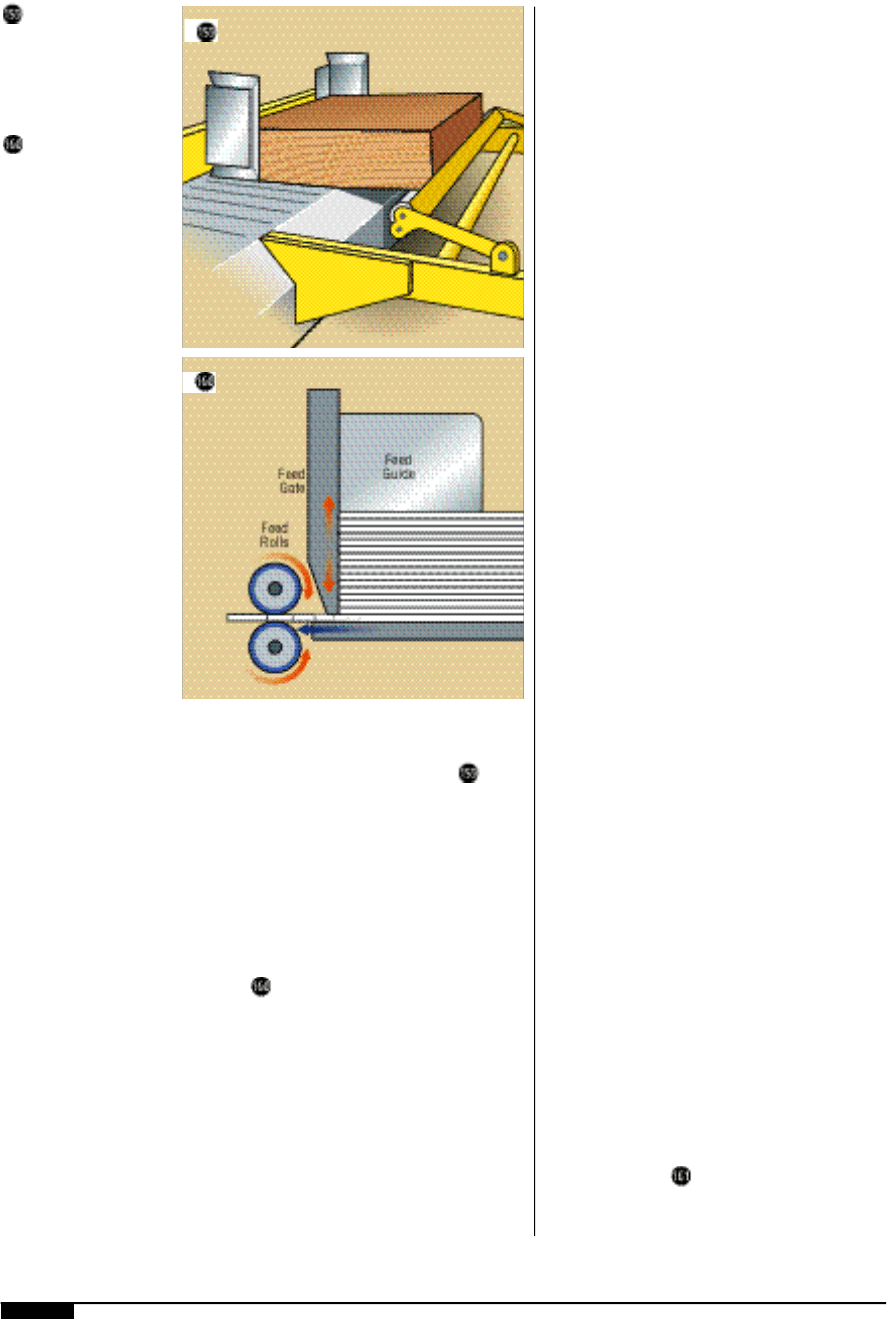
210 FLEXOGRAPHY: PRINCIPLES & PRACTICES
most operating conditions (Figure ) .
The next step in the setup of the feeding
device is to set the feed roll. On manually set
machines, the feed roll is set with a locking
lever adjustment. The feed roll has an up and
down adjustment. It must be set tight
enough to grip the blank so as to prevent
slippage as the blank enters the press
(F i g u r e ). More feed-roll pressure is
required on prescored blanks than on non-
prescored blanks to prevent score-line slip-
page of the blank when it is entering the nip
of the rolls. Score-line slippage can cause
print and slot variation. On many newer
presses, the feed-roll setting is done with a
computer using motorized methods.
All feed sections have a caliper setting
adjustment, which consists of a handle that
raises and lowers the rolls. The caliper set-
ting should be set to the caliper of the board
being run. Often, the caliper readings on the
presses are approximate due to feed-roll
wear or play in the gear mechanism. If this is
the case, the machine should be recalibrated
to eliminate error and board crush.
Check Plates to Print Card
After the press-feed section has been set,
and before the plates are mounted in the
press, the plates should be checked against
the print card to verify that the copy is cor-
rect for the job to be run. Once the copy has
been verified, the plates should be checked
for damage, ink and wax buildup, dirt from
previous runs and proper bonding to the car-
rier sheet.
Select the Print Stations
Before the plates are mounted to the print-
ing cylinder, the operator must determine
which print station to use for each color.
When selecting the print station, considera-
tion should be given to how the graphics
must be trapped. The graphics are usually
prepared on the plates to have the ink colors
printing from lightest to darkest, allowing the
darkest ink color to trap the lightest in areas
where there is registration between colors.
The subsequent colors hide the lighter color
beneath it to create good trapping.
Mounting the Plates
to the Print Cylinders
Plates should be mounted on the appropri-
ate plate cylinders after a decision has been
made about which station to use for each
color based on the trapping requirements of
the graphics.
There are various methods used to mount
the plates on corrugated presses. The fol-
lowing three methods are typically used:
• In F i g u r e , individual plates are
mounted onto the plate cylinders using
scribe lines that are engraved on the
A lead-edge feeder
transports the board to
the press by grabbing
it from the lead, or
front edges.
Feed rolls must be set
tight enough to grip the
blank so as to prevent
slippage as the blank
enters the press.

cylinder. Scribe lines on the plate cylin-
der are also used to position plates that
are premounted on a carrier that has a
center mark. The center mark on the car-
rier is positioned to a cylinder’s center
scribe line and adhered.
• The plate cylinder is magnetized and the
plates either have a metal backing or are
positioned on a metal carrier. The mag-
netism of the plate cylinder holds the
plates in position without the use of tape
or straps.
• The plate cylinder uses a clamping system
to hold the mounted plates. The plates are
premounted on a carrier that has a
hooked lead edge. This edge is attached to
a bar and clamp mechanism on the lead
edge of the plate cylinder. The trailing
edge of the carrier is then attached to the
plate cylinder with straps, clamps or tape
(Figure ).
Set the Pull Rolls
The purpose of pull rolls is to control the
movement of the sheet from one print sta-
tion to the next without slippage or change
in board speed. These rolls control the print-
to-board register throughout the press.
The operator can set the pull rolls either
manually or with a motorized system. The pull
rolls are set in a position to ride on the ends of
the sheet and away from any printed copy.
Running pull roll collars over the printed
image may cause ink smearing on the board.
Set the Ink Distribution System
The ink distribution system should be set
up to maintain a constant, uniform supply
of ink during the pressrun (Figure ).
Ink the Print Stations
The next step in the setup procedure is to
ink up the print stations. The following pro-
cedure details a typical print station inking:
1. Double-check the color in the ink con-
tainer to verify that it is the color to be
placed in that print station.
2. Circulate the ink in the ink pump
through the supply hose back into the
pump to remove air from the system.
3. If an ink pan is being used, align the ink
pan and lock down the hold-down
mechanism. Ensure that the pan will
not rub on the ends of any rolls or the
surface of the plate cylinder.
4. Connect the return hoses from the ink
pan to the ink pump, making sure they
are routed around any moving parts. If
using submersible pumps, return hoses
must be slightly submerged in the ink
of the ink-pumping unit to help avoid
foaming with water-based inks.
PRESSROOM PRACTICES 211
Scribe lines engraved
on the cylinder
facilitate positioning
of the plate during
mounting.
In this mounting
system, a hooked edge
on the plate carrier is
fitted to a clamp on
the cylinder to provide
a strong fit. A clamp
at the trail end of the
carrier sheet provides
additional support.
Tension Clamp
Carrier
Sheet
Printing
Plate
Leading Edge

212 FLEXOGRAPHY: PRINCIPLES & PRACTICES
5. Connect the supply hose from the
pump to the ink-distribution system.
6. Pump the ink into the distribution sys-
tem.
7. After the ink has been pumping for a
time, check the pH and viscosity. These
measurements are done to ensure that
the ink is at its running parameters be-
fore the pressrun begins. If the ink does
not meet specifications, it should be
adjusted and rechecked until it does.
Set the Fountain Roll
and/or Doctor Blade
Once the ink is in the fountain and is with-
in its recommended running pH and viscosi-
ty parameters, the anilox roll may be inked.
When using a two roll system (Figure ),
the fountain roll is adjusted to squeeze against
the anilox roll. Once the press is started, the
rubber roll is adjusted to evenly squeeze the
ink off the anilox using the minimum amount
of pressure. This pressure setting is checked
by backing the fountain roll off until the oper-
ator can see the nip flood with ink. Then the
operator squeezes back in with both sides of
the rubber roll, making sure they are even,
until the flooding on the surface goes away. By
doing this several times, the ink wipe is set.
When setting a station with a doctor blade
(Figure ), the doctor-blade assembly is
set into its holder and then slowly tightened
down until it touches the anilox. As the blade
is tightened to the anilox, the operator will
notice that the ink will meter from the center
of the anilox roll outward to the ends. When
An ink distribution
system should be
configured to maintain
a constant, uniform
supply of ink during
the pressrun.
Anilox Roll
WiperRoll
Ink Pan
Filter
Air
Supply
Ink
Bucket
Pump
Return
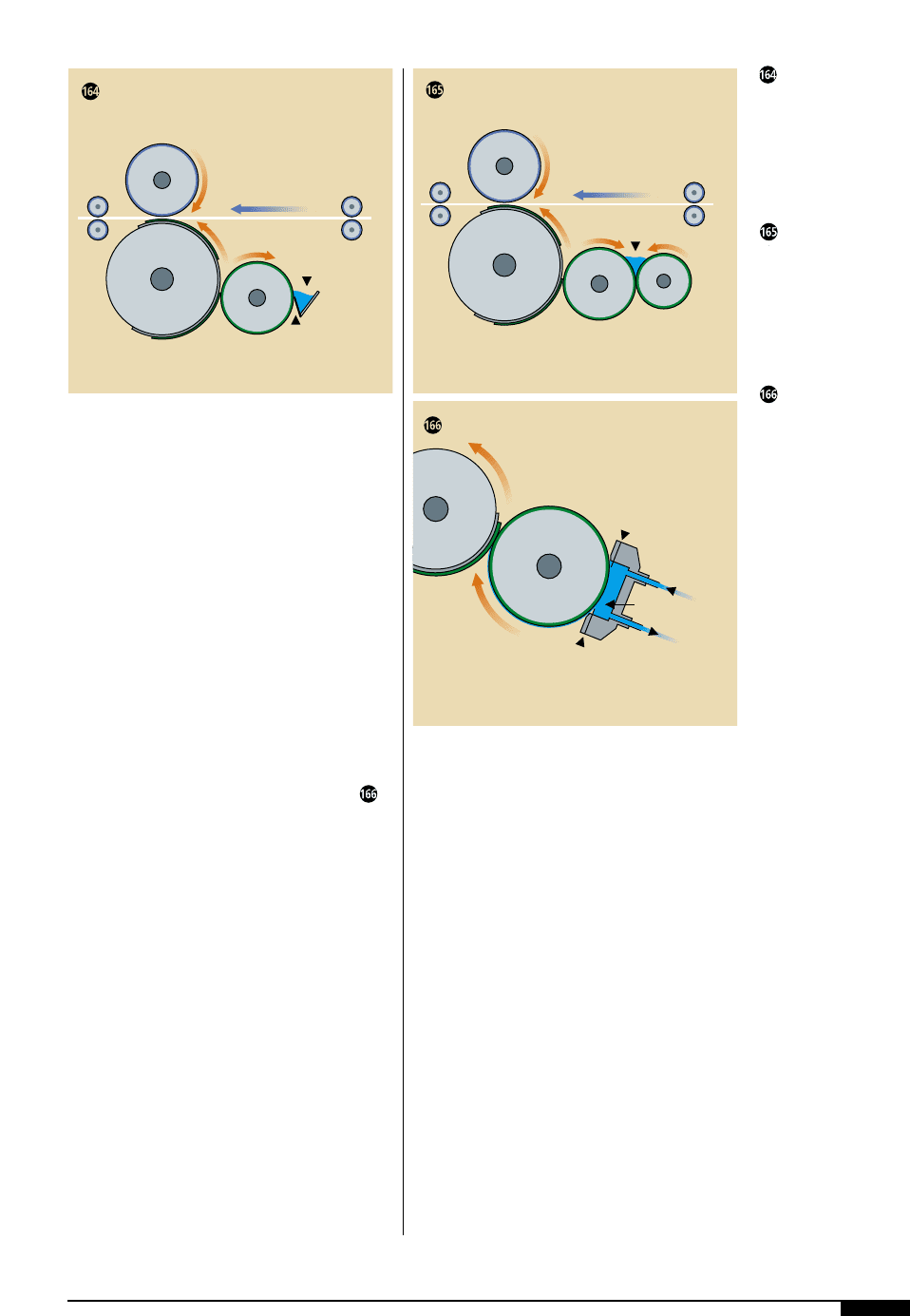
the ink is metered off of the ends of the
anilox roll, the wipe is set. Similar to the pro-
cedure for setting fountain roll pressure, the
doctor blade should be backed out and
brought back in to the anilox several times in
order to set the wipe with the minimum
amount of pressure. Overtightening the doc-
tor blade can cause the blade to fold under
the pressure, causing the ink to dry due to
the friction and heat buildup behind the
blade. If ink drying occurs, the dried ink pig-
ments can cause damage to the anilox roll.
If the press is equipped with a cham-
bered doctor-blade assembly (Figure ),
the assembly is installed before the pump
is turned on. The ink wipe should be set in
the same manner as a single blade.
Adjust Print Impression
Print impression is measured in thou-
sandths of an inch with a micrometer. The
amount of pressure needed to transfer ink
to the surface of the board is dependent
upon the following:
• printing plate caliper;
• substrate porosity;
• board grade;
• ink transfer characteristics; and
• substrate texture.
On some presses, the impression setting is
adjusted automatically by means of comput-
erized controls. The computer may be pro-
grammed for settings of various board
calipers. On other presses, the operator must
manually set the impression by following
scales for the approximate setting. In either
case, the operator must fine-tune the setting
to achieve the minimal pressure needed to
transfer ink.
Print impression should be set as light as
possible since excessive impression will
crush the board’s flutes and cause box com-
pression-strength failure. Excessive impres-
sion may also cause fine print to distort and
reverses to fill in. The actual impression
needed on a board is determined by running
boards through the press at run speed
instead of jog speed. A portion of a board is
PRESSROOM PRACTICES 213
In a two-roll system,
the fountain roll should
contact the anilox with
the minimum amount
of pressure necessary
to evenly squeeze ink
off the anilox.
When using a doctor-
blade assembly,
the blade should be
placed in its holder,
then slowly tightened
until it touches the
anilox.
A chambered doctor-
blade system must be
installed before the ink
pump is turned on.
Impression
Cylinder
Sheet Travel
Plate
Cylinder
Printing
Plate
Feed
Rolls
Pull
Rolls
Reverse Angle
Doctor Blade
Anilox
Roll
Ink Nip
Impression
Cylinder
Sheet Travel
Plate
Cylinder
Printing
Plate
Feed
Rolls
Pull
Rolls
Wiper
Roll
Anilox
Roll
Ink Nip
Anilox Roll
Reservoir
Ink “Out”
Return
Ink “In”
Supply
Containing
Doctor Blade
Metering
Doctor Blade
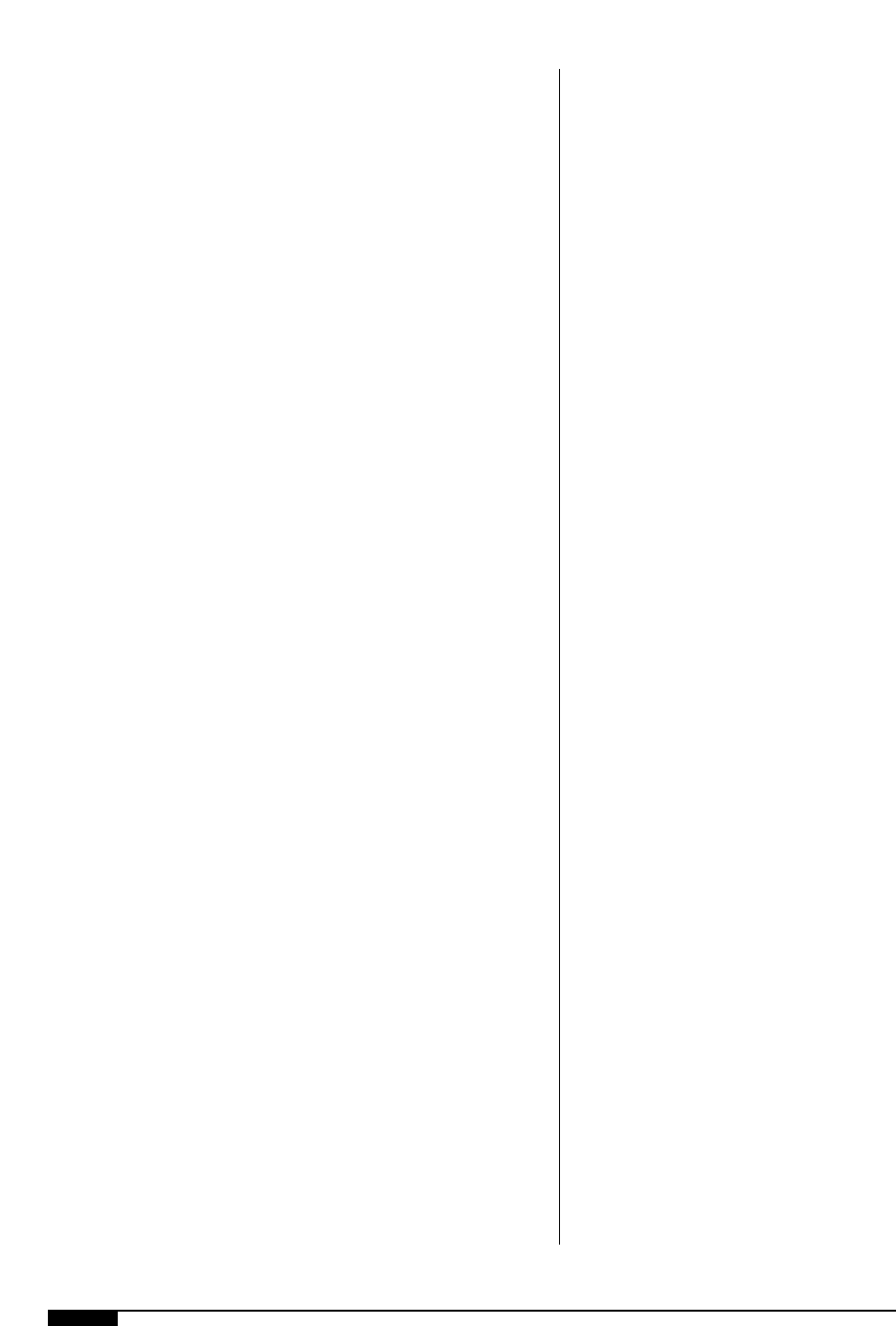
214 FLEXOGRAPHY: PRINCIPLES & PRACTICES
bases to reach the color standard. All of the
information from the color-matching process
should be documented so the job can be
reprinted without additional downtime.
Press Setup Checklist
Before the pressrun begins, most com-
panies require that a press setup checklist
be filled out. A checklist ensures that all
the details of the job setup are covered
and documented for any future runs.
Information on the checklist may include:
• ink pH and viscosity;
• print location;
• ink color;
• stock;
• copy accuracy;
• feed-roll impression;
• print impression;
• pull-roll impression;
• print clarity;
• plate condition; and
• anilox configuration.
Setup time is expensive, especially when
it must be redone. Proper setups and con-
stant verification of the product during the
pressrun saves time and money.
PRESSRUN PROCEDURES
The attention to detail that marked the
setup process must carry over into the
pressrun. The next section describes main-
tenance that takes place once the press is
running.
Monitor Ink pH and Viscosity
In order to maintain the ink’s color-to-stan-
dard match throughout the pressrun, pH and
viscosity must be monitored. Without moni-
toring, the color will vary, resulting in incon-
sistent product. Ink pH and viscosity must
also be monitored to ensure proper trapping
between colors, good ink resolubility, good
print quality and correct ink drying between
cut out, calipered and saved in order to mea-
sure feed roll crush. The remainder of the
board is fed through the press. The thickness
of the unprinted area of the board is mea-
sured and compared to the saved piece to
determine any difference in caliper. Correct
print pressure is checked by comparing the
caliper of the printed area to the caliper of
the unprinted area. Once the feed-roll pres-
sure and print-impression pressure is adjust-
ed, the printed images are registered to the
board and to the other colors.
Check Colors to Standard
Once the press is set up and all settings are
complete, the printing must be checked for
accuracy against the color standard that was
approved by the customer in the design
stage of the job. A color standard may be an
ink sample on the board being printed, a
GCMI color chip or a printed sample from a
previous run.
All visual color-matching should take
place in a viewing booth designed for this
purpose. This type of booth provides a stan-
dardized light source with a neutral gray
background to eliminate color variations
caused by the lighting conditions during the
color-matching process.
A sample of the print should be compared
to the color standard to ensure that the print-
ed job meets the customer’s requirements.
The operator should check to make sure the
color is printing at the correct density (light-
ness and darkness) either visually or with the
use of a densitometer. If the color is not print-
ing at the correct density, the anilox may be
changed to achieve a density match with the
standard. For slight density changes that are
needed, the ink viscosity may be changed by
adding water, or the ink may be extended to
reach the color standard.
The ink hue should also be checked visu-
ally in a light booth or with the aid of a spec-
trophotometer. If changes in hue are needed,
the operator should add the correct ink
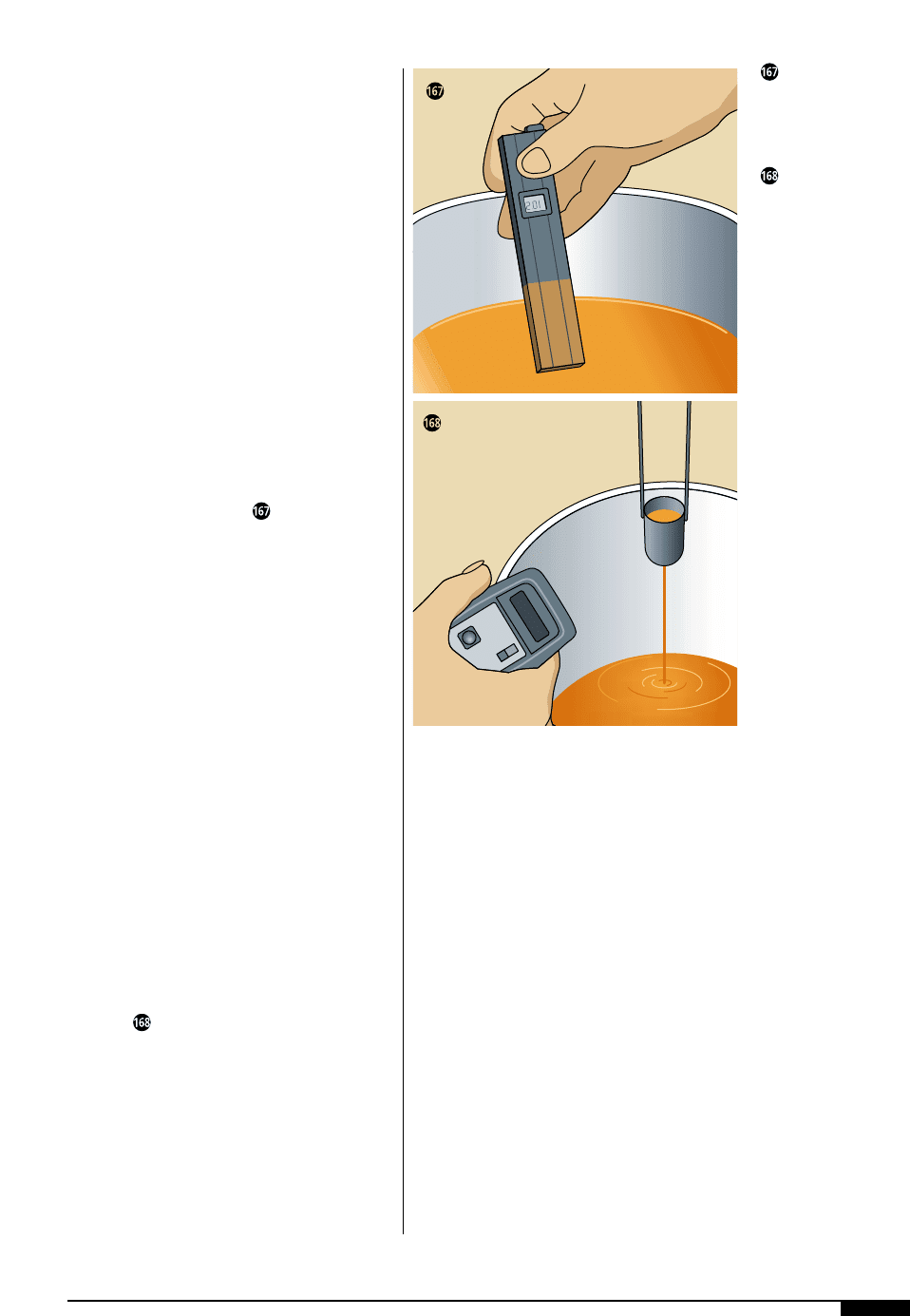
print stations, especially if the press does
not have between-station dryers.
Water-based inks should be run in a spe-
cific pH range to keep them working effi-
ciently. The pH ranges vary by ink manu-
facturer and the requirements for the job.
Generally, water-based inks are in the pH
range of 8.0 to 9.3. When the pH of a water-
based ink falls too low, the ink will begin
to body and thicken, eventually causing
rewetting problems and dirty printing. If
the pH is too high, the viscosity of the ink
will be too low, causing drying problems.
Color variations and print defects caused
by pH levels can be eliminated by main-
taining pH within its recommended range.
A pH meter is the instrument used to
read pH levels (Figure ). These instru-
ments should be calibrated to a buffer solu-
tion with a known pH on a regular basis.
To help control drying and to provide bet-
ter trapping between colors, the pH value
should decrease slightly from print station
to print station, starting from the ink station
closest to the in-feed and going to the out-
feed section. Because the pH level controls
the drying of water-based inks, this pH
decrease helps the ink to dry properly
before the next ink-down hits the board,
providing better trapping between colors.
Because the pH level of water-based inks
controls overall ink performance, pH should
always be checked before viscosity. Adjust-
ments made to viscosity alone may also
change the pH, causing other print prob-
lems. The pH and viscosity of water-based
inks should be checked every 30 minutes
(Figure ).
Water and amine are used to control vis-
cosity in water-based ink systems. A stabiliz-
ing varnish may also be used, which is a water
and amine combination that has been pre-
mixed to the correct percentages for the ink
system being used. An addition of stabilizing
varnish should lower the ink viscosity while
maintaining the pH of the ink. Water alone
will reduce the viscosity, but it may also
reduce pH, and cause other print problems.
Ink reducers may also be used to control vis-
cosity. Adding small amounts of reducer
should maintain correct viscosity. The viscos-
ity level should never get so high that more
than a pint of reducer is required to return the
viscosity to the correct level. The careful con-
trol of pH and viscosity levels for water-based
ink results in consistent color and uniform
ink flow throughout the production run.
Adding Ink to the Fountain
During longer runs, the press operator
may be required to add ink to the fountain or
pump. This addition requires specific atten-
tion to detail. The following text details a
typical ink addition procedure:
PRESSROOM PRACTICES 215
During the pressrun,
pH can be quickly
checked through the
use of a pH meter.
One method of
checking viscosity
is by timing ink flow
through a Zahn cup.
M
IN
S
E
C
/1
0
0
